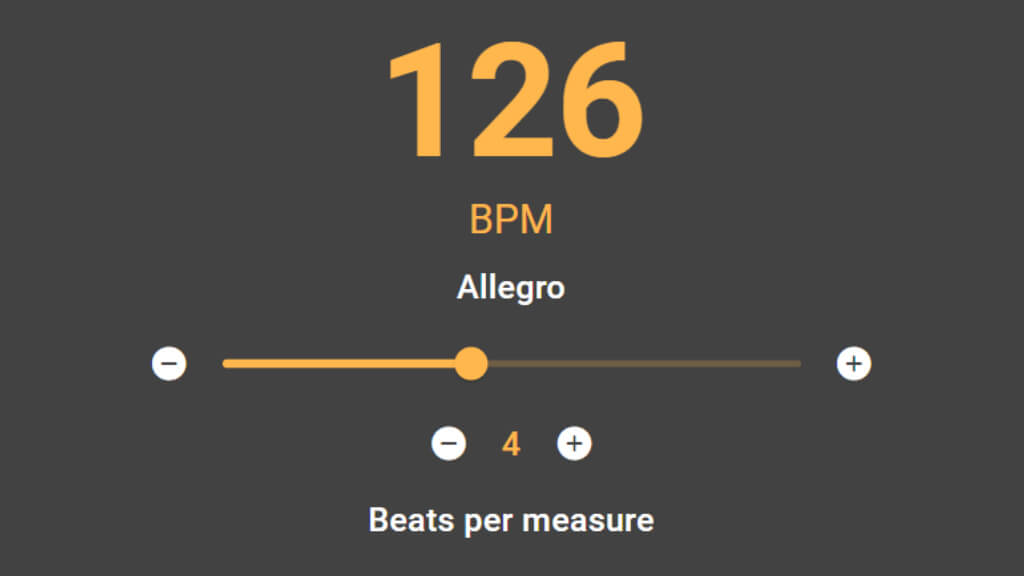Metronome for Precise Timing in Music Practice
Welcome to our free online metronome — the perfect tool for maintaining a steady rhythm while playing your instrument. Whether you are a guitarist, pianist, or drummer, this metronome will help you sharpen your sense of timing and play with precision. It supports tempo adjustment, custom beats per measure, and offers simple playback controls.
How to Use the Metronome
The online metronome lets you set a precise beat for practicing technique, learning new pieces, or simply staying in time as you play. To get started:
- Choose your desired tempo (BPM) using the slider or buttons.
- Set the number of beats per measure — for example, 2, 3, 4, or 6.
- Press the “START” button to begin the metronome.
- Press “STOP” when you are finished.
All your metronome settings are saved, so you’ll pick up right where you left off on your next visit.
Tempo Settings
Tempo is the speed at which the metronome ticks. It’s measured in BPM (beats per minute). The higher the number, the faster the rhythm.
You can adjust the tempo:
- Using the slider to pick a value from the scale.
- Or with the + and – buttons for fine-tuning.
It’s best to start practicing at a slow tempo and gradually increase it as your accuracy improves.
Musical Tempo Markings
In music, tempo is often indicated not only by beats per minute (BPM) but also by traditional Italian terms. These help convey not just the speed but also the character of the performance. Here are the main ranges:
- Larghissimo (up to 20 BPM) — extremely slow, almost motionless. Common in meditative, experimental, and atmospheric music.
- Grave (20–40 BPM) — very slow, heavy, and solemn. Suitable for dramatic or ceremonial pieces.
- Largo (40–60 BPM) — broad, calm, and flowing. Often used in slow movements of classical works.
- Adagio (60–76 BPM) — slow and expressive. A moderately calm tempo ideal for lyrical melodies.
- Andante (76–108 BPM) — at a walking pace. A balance between calmness and motion.
- Moderato (108–120 BPM) — moderate, neutral tempo. Versatile across many musical styles.
- Allegro (120–168 BPM) — fast and lively. One of the most common tempos for energetic pieces.
- Vivace (168–176 BPM) — very lively and brisk. Often used in bright, upbeat finales.
- Presto (176–200 BPM) — very fast. Ideal for dynamic passages and technically demanding music.
- Prestissimo (200–220 BPM) — extremely fast, near the limit of playability.
- Molto Prestissimo (220–240 BPM) — ultra-fast tempo, found in virtuosic or experimental music.
- Graveyard Shift (over 240 BPM) — a humorous, informal term for extreme speed. Found in speed metal, chiptune, and avant-garde genres.
These markings can help you choose a tempo that fits the mood and your level of skill. They are especially useful when working with classical compositions or interpreting score annotations.
Beats Per Measure
Setting the number of beats per measure allows you to match the metronome to different time signatures:
- 2 beats — great for marches or simple pop tunes.
- 3 beats — ideal for waltzes and triple meter rhythms.
- 4 beats — the most common time signature in rock and pop music.
- 6 beats — useful for more complex rhythms and phrasing.
Each first beat of the measure is accented to help you stay oriented within the rhythm.
Why You Should Use a Metronome
Even experienced musicians regularly practice with a metronome. It helps you:
- Develop a strong internal sense of rhythm.
- Play steadily and consistently without drifting.
- Improve timing precision.
- Prepare for playing in an ensemble, band, or orchestra.
A metronome is especially useful when working on challenging passages, arpeggios, picking patterns, phrasing, and accent shifts.
Works Offline — Anytime, Anywhere
You can install our metronome as a Progressive Web App (PWA) and use it even without an internet connection — during rehearsals, on the go, in lessons, or at home. It’s especially convenient on smartphones, tablets, and desktop devices.
On Android and tablets:
- Open the site in the Chrome browser.
- Tap the three dots in the top-right corner.
- Select “Install app” or “Add to Home screen”.
- Confirm the installation and follow the on-screen instructions.
On desktop (Windows, macOS, Linux):
- Open the site in Chrome or Edge.
- Look for the “Install” icon in the address bar and click it.
- If you don’t see the icon, open the menu (three dots) and choose “Install”.
- The app will launch in a separate window and appear in your Start menu or Applications folder.
You can also simply bookmark the site so the metronome is always just a click away.
Keep perfect time with our free online metronome. Ideal for musicians of all levels to improve timing and rhythm.













